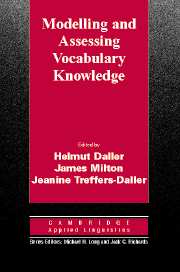Book contents
- Frontmatter
- Contents
- List of contributors
- List of abbreviations
- Acknowledgements
- Foreword
- Series Editors' Preface
- Editors' introduction
- I Fundamental issues
- II Vocabulary and learner differences
- III The unit of assessment and multiple vocabulary measures
- Chapter 4 Validity and threats to the validity of vocabulary measurement
- Chapter 5 Comparing measures of lexical richness
- Chapter 6 Productive vocabulary tests and the search for concurrent validity
- Chapter 7 Exploring measures of vocabulary richness in semi-spontaneous French speech
- Chapter 8 Lexical richness and the oral proficiency of Chinese EFL students
- IV Metaphors and measures in vocabulary knowledge
- V Vocabulary measures in use
- References
- Appendices
- Index
Chapter 4 - Validity and threats to the validity of vocabulary measurement
Published online by Cambridge University Press: 04 May 2010
- Frontmatter
- Contents
- List of contributors
- List of abbreviations
- Acknowledgements
- Foreword
- Series Editors' Preface
- Editors' introduction
- I Fundamental issues
- II Vocabulary and learner differences
- III The unit of assessment and multiple vocabulary measures
- Chapter 4 Validity and threats to the validity of vocabulary measurement
- Chapter 5 Comparing measures of lexical richness
- Chapter 6 Productive vocabulary tests and the search for concurrent validity
- Chapter 7 Exploring measures of vocabulary richness in semi-spontaneous French speech
- Chapter 8 Lexical richness and the oral proficiency of Chinese EFL students
- IV Metaphors and measures in vocabulary knowledge
- V Vocabulary measures in use
- References
- Appendices
- Index
Summary
Introduction
In the first chapter of this volume, Paul Nation draws our attention to six factors that are potential threats to the validity of language assessment. By way of introduction to this chapter we will briefly consider three of these before concentrating on issues connected with ‘multiple measures’ and ‘the unit of counting’ in more detail. We will omit ‘testing vocabulary in use’, but not because we do not think it is important. More naturalistic approaches to language testing including aspects of normal language use are advocated in many areas of applied linguistics (see Porter, 1997, on second language oral testing; Wells, 1985, on early first language assessment; Holmes and Singh, 1996, on vocabulary in aphasia; Bucks, Singh, Cuerdon and Wilcock, 2000, on analysing lexical performance in dementia patients). Issues that touch on this will be addressed under ‘multiple measures’.
All three remaining factors discussed by Nation – frequency lists, learner attitude, and first and second language formats – strike a chord with our own concerns related to research, language teaching, and the education of teachers. In the past, we have been sceptical about the use of word-frequency lists in second language assessment (Malvern, Richards, Chipere and Duràn, 2004). At lower and even intermediate levels, exposure to vocabulary can be too limited and too heavily biased towards the lexical idiosyncrasies of teachers and textbooks for native speaker norms to be a reliable metric. Recently, however, we have been forced to think again.
- Type
- Chapter
- Information
- Modelling and Assessing Vocabulary Knowledge , pp. 79 - 92Publisher: Cambridge University PressPrint publication year: 2007
- 10
- Cited by



